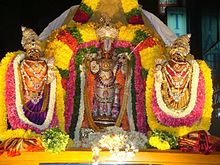| Ranganatha | |
|---|---|
God of Srirangam | |
 Festival image of Ranganatha flanked by consorts Sridevi and Bhudevi | |
| Affiliation | Sri Vaishnavism |
| Abode | Vaikuntha, Kshira Sagara |
| Mantra | Om Namo Narayanaya |
| Weapon | Sudarshana Chakra and the Kaumodaki |
| Mount | Garuda |
| Temple | Srirangam |
| Consorts | Ranganayaki as Sridevi, Bhudevi, Niladevi |
| Part of a series on |
| Vaishnavism |
|---|
 |
Ranganatha, also known as Ranganathar, Rangan, Aranganathar, Sri Ranga, and Thenarangathan, is a Hindu deity with his origin in southern India, serving as the chief deity of the Sri Ranganathaswamy Temple, Srirangam. The deity is a resting form of Vishnu, recumbent on the great form of the serpent god Adishesha, the king of the serpents. His primary consort is the goddess Lakshmi, also known as Ranganayaki. The two other consorts seen next to his recumbent figure are Bhudevi and Nila Devi. Most of the deities portray a 'smiling' lord in a sleeping or reclining position over the celestial serpent Adishesha in the sea of cosmic dissolution (pralaya).[1] This is the form in which he is open to listening to all of his devotees' woes, and blesses them. Apart from being worshipped by all Hindus, this form is of particular importance to the Sri Vaishnava community.[2][3] His name in Sanskrit means "leader of the place of assembly", coined from the two Sanskrit words ranga (place) and natha (lord or leader).[4]
Symbolic representation of Ranganatha and Nataraja has been compared as the meaning of both is the same except for their locations. In Ranganatha, ranga means "stage" and which in the broadest sense refers to "the world, the cosmos or better still of the body and the senses". Nataraja also means the "Lord of the Stage" and in this case his stage is in ‘Chidambaram’ meaning the "sphere of wisdom", while Ranganatha rests on the Ocean of milk or Thiruparkadal, which is a metaphysical or esoteric concept which is not easy to interpret as it is perceived in different ways by different people.[5] The name "Nataraja" is more usually taken to mean Lord of the Dance in reference to the dance of dissolution, or pralaya, or alternatively the dance of illusion by which the material sphere is manifested, and is therefore a name for Shiva, as distinct from Vishnu.
There is also a famous temple dedicated to Shree Ranganatha swamy in Shakarayapatna in Chikmagalur district in the southern region of Karnataka.


- ^ James G. Lochtefeld (2002). The Illustrated Encyclopedia of Hinduism: Volume Two. The Rosen Publishing Group. pp. 643–. ISBN 978-0-8239-3180-4. Retrieved 12 December 2012.
- ^ Srinivasan (15 June 2011). Hinduism For Dummies. John Wiley & Sons. pp. 57–. ISBN 978-1-118-11077-5. Retrieved 12 December 2012.
- ^ Deshpande 2005, pp. 263–64.
- ^ Isacco, Enrico (1982). Krishna, the Divine Lover: Myth and Legend Through Indian Art. Serindia. p. 211. ISBN 978-0-906026-11-3.
- ^ Symbolism in Hinduism. Chinmaya Mission. 1983. pp. 102–103. ISBN 978-81-7597-149-3. Retrieved 13 December 2012.[permanent dead link]
© MMXXIII Rich X Search. We shall prevail. All rights reserved. Rich X Search
